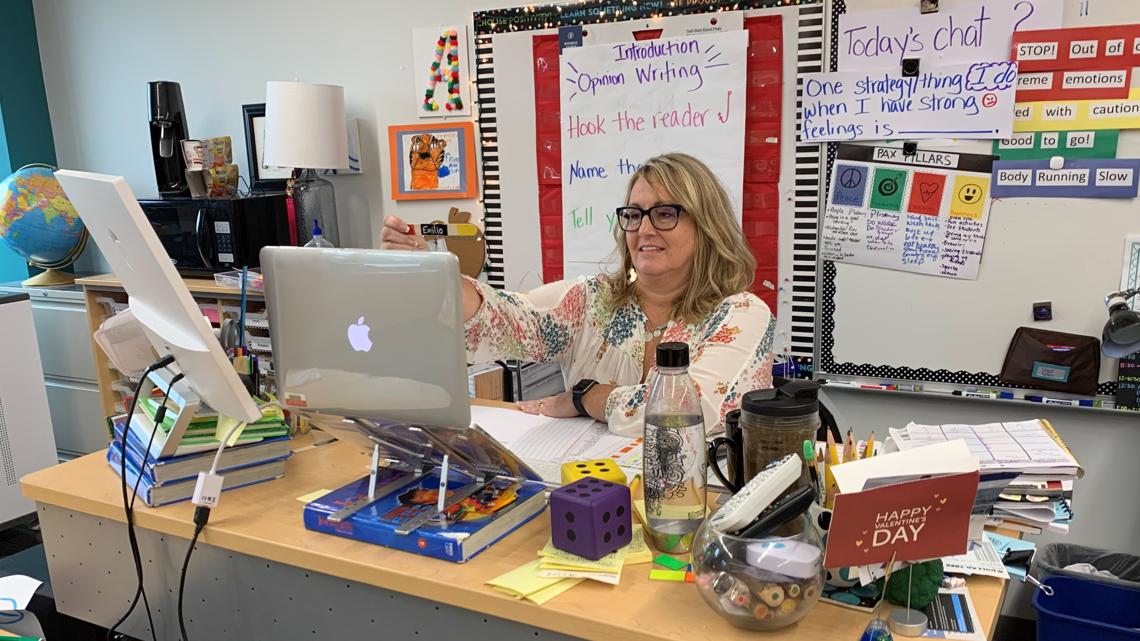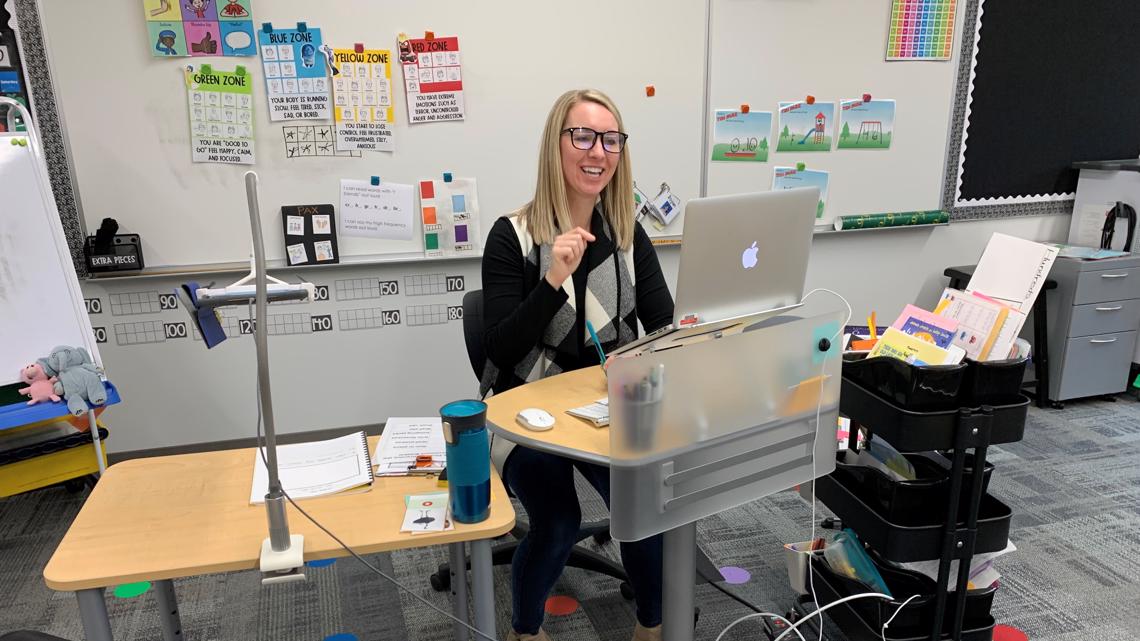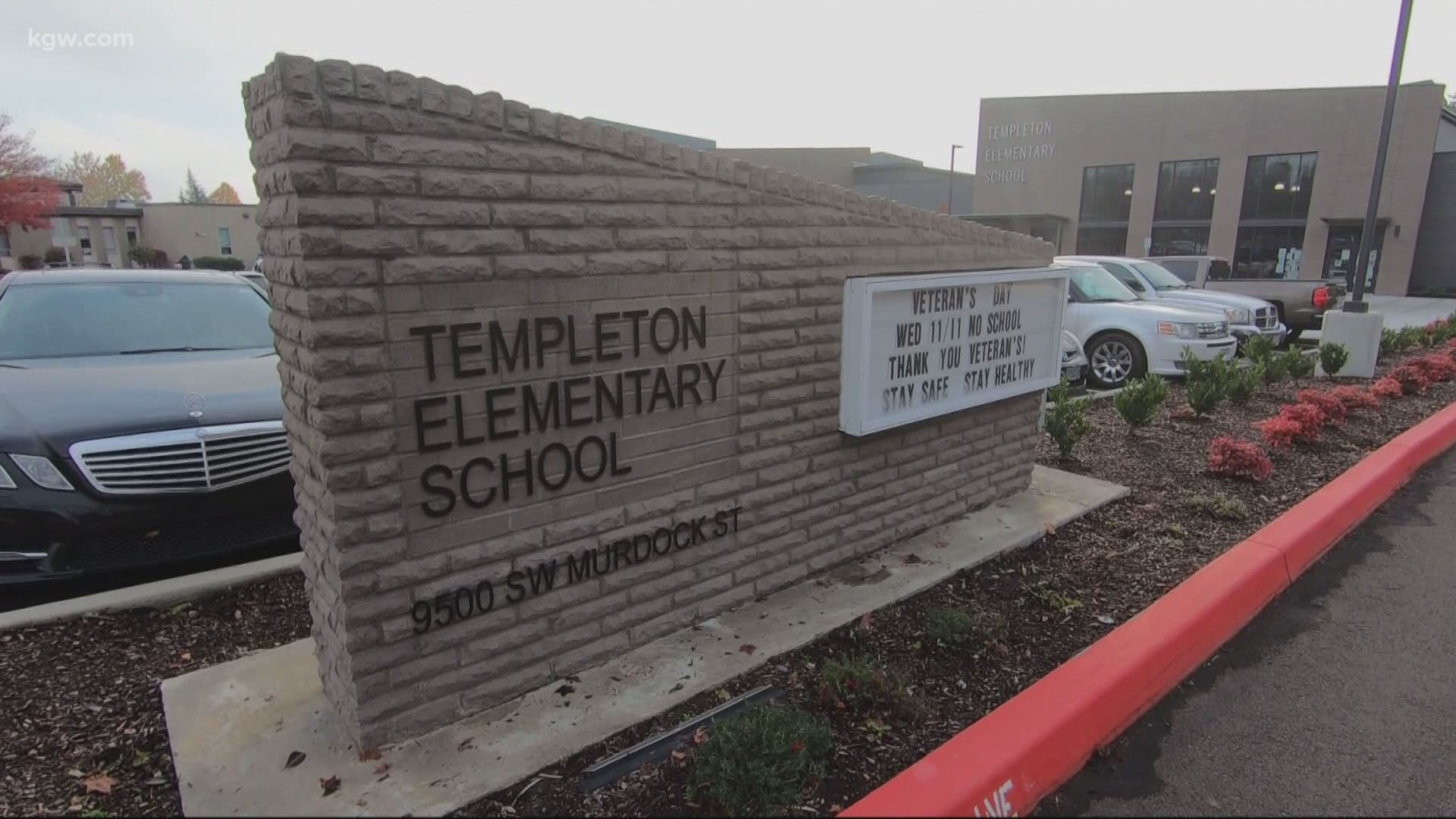TIGARD, Oregon — It’s not easy but teachers are making distance learning work as best they can. Some have decided to teach from home while others are doing it from the comfort and familiarity of their own classrooms.
Teachers have had to navigate distance learning for a couple months now, so KGW's Christine Pitawanich decided to check in with a couple teachers in the Tigard-Tualatin School District to see how things are going for them.
DeeAnn Albaugh is a fourth grade teacher at Templeton Elementary. Every day, she arrives around 8 a.m.
“I have to sign in what time I got here. I have to answer some questions regarding my health,” said Albaugh.
“[I] come up to my classroom and just get settled for the day.”
Once inside her classroom, Albaugh takes off her mask. She said teachers in her district have the choice as to whether they want to work from home or their classroom in the actual school building. Albaugh chooses to work out of her classroom.
“This allows me to keep my class as 'normal,' quote unquote, as possible,” she said.


Albaugh said additionally, it’s easier this way because if she worked from home, she’d have four adults who would have to use the internet.
Look around Albaugh’s classroom and it looks like your average classroom, with decorations and books, but there are no kids. She sees her students online starting at 8:30 in the morning. They get individualized greetings. From air hugs to low high fives, Albaugh spends time making her kiddos feel welcome.
As students would during a typical in-person school day, they all say the Pledge of Allegiance together virtually, then have a quick check-in with the class pet, Squirtle the turtle. Albaugh put the laptop camera right up to the tank so her kids could get a look at their beloved turtle and say "hi" to the pet.
"We're into a groove."
She and so many other teachers, kids and families know that this year hasn’t been a walk in the park, but Albaugh says it’s getting better.
“We’re into a groove. So it feels really good. The beginning of the year was hard. It was really hard,” said Albaugh.
She said her moments of frustration and sadness center on the kids.
“I can’t be there for them. I’m not giving them what they need. That’s the hardest thing for me,” Albaugh said.
The difficulties of technology
In addition to new learning platforms and new curriculum, she also had to learn how to be something of a web designer as she created her classroom webpage.
While she said the process of learning about all the technology pushed her boundaries, she realized that’s how her students might feel about certain concepts they might not be familiar with.
“It gave me great perspective and actually gave me some real purpose,” she said.
Albaugh said the main hurdle for her is technology. Sometimes kids’ internet will drop out and they’ll have to rejoin the classroom after some frustration. But Albaugh said her students are fortunate. Each of her 20 kids has a device and internet. At the beginning of the year she also connected with parents and everyone agreed to having cameras on.
“The best accountability is to have the camera on,” said Albaugh. That way, she can make sure kids are staying on task and not getting too distracted.
She said if a student doesn’t log on, she texts their parents.
Albaugh said she’s been honest and upfront with her kids from the get-go.
“We talk about it being hard. I say I don’t like online learning, I don’t. You don’t like online learning. No one does, but it is what we have right now, so we have to make the best of it.”
“Every day I try to model […] resilience,” she said.
What another teacher has to say
Meantime, over in Mrs. Amie Rose’s room her first graders were getting ready for their day too.
“What are we gonna do to wake up our brains? Push-ups,” Rose cheerfully said to her kids on the computer screen.


Like Albaugh she feels like things are finally getting into a groove.
“[We’re] getting into a daily routine, our kids are understanding how to submit things,” said Rose.
“Nobody chooses to teach online. But given the cards we were dealt, it was a really steep learning curve at first,” she said.
Rose agreed with Albaugh regarding how technology can be tough, especially if kids don’t have an adult at home who can help them troubleshoot.
Concern for students
At this point, Rose said some first graders are still learning letters and sounds. Right now, her biggest worry is reading.
“Trying to keep that exciting and engaging on a screen has been a big challenge, and it’s a big worry for them moving forward because if reading is hard now, it’s not going to become any easier as they continue on their schooling experience,” said Rose.
She said she and her team have had to be proactive about trying to send out as many materials and packets as possible to ensure the kids are up to par on their reading skills.
As other teachers elsewhere have said, motivation to be fully present during class can be difficult for Rose’s first grade students. She said she and her team are constantly working to keep the kids engaged.
Her bright spot each day is the excitement she sees from her students. Rose said they love seeing each other and her, even if it is virtually.
“Just seeing them every day is what makes it a lot better,” said Rose.
Rising to the challenge and resiliency
Carrie Ferguson, the principal at Templeton Elementary, said the sense of pride she has in her teachers, parents and students is immeasurable.
“This is not easy work, but we’re stronger than the barriers in front of us,” said Ferguson. “There’s a lot of really good things happening even though this is a really difficult time.”
While neither Rose or Albaugh said they had ever gotten to the point of tears due to frustration associated with online learning, they acknowledge there have been many frustrating moments. Throughout the pandemic, other teachers have had a very different experience, crying at various points in the day due to the stress of online teaching. Albaugh said each teacher’s experience is unique depending on what life circumstances they’re facing.
She said right now teachers are just doing their best. They are learning to be resilient, as are their students and families.
“The hardest thing is looking at their faces online and knowing they want to be here, and I want them here. That makes me really sad. I can’t spend too much time on that though because I don’t have a choice. We have a pandemic and we have to be safe, and safety is the number one thing. We talk about that,” said Albaugh.
“We’re gonna be better for this,” she said.

